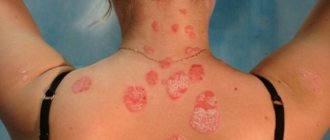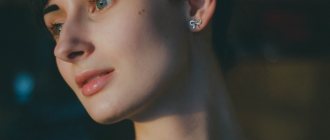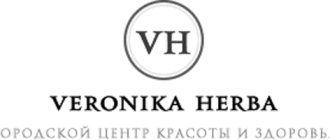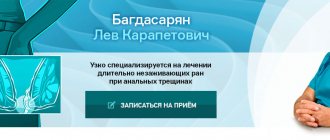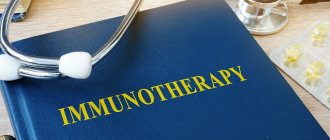Diseases that begin with the letter “L”: Lactostasis, Laryngitis, Laryngotracheitis, Cor pulmonale, Pulmonary fibrosis, Leukemia, Leukemia in children, Leukoplakia, Leucinosis, Leprosy, Dental treatment, Lymphadenitis, Lymphangitis, Lymphogranulomatosis, Lymphoma, Lymphostasis, Lipoma, Listeriosis , Lichen, Pediculosis pubis.
Ringworm belongs to the group of dermatological diseases of the fungal and viral type. It is characterized by the appearance of dry or weeping areas of skin that periodically itch severely. Ringworm is a fairly common disease and it is customary to distinguish several varieties depending on:
- causes of occurrence (causative agent);
- type of change in the structure of the skin;
- location;
- degree of infectiousness to others.
The disease has a long development period and a high risk of relapse.
Why does lichen appear?
It is difficult to name with 100% certainty the exact causes of infection and the method of formation of the lichen patch on the skin. However, there are a number of factors that provoke the appearance of the disease:
- low level of immunity;
- constant exposure to stressful situations;
- chronic emotional and physical fatigue;
- infections;
- genetic predisposition to skin diseases.
Even the gender and age category of the patient can influence the form of the disease.
The causes of lichen also depend on its type.
Shingles appears due to contact with the Herpes zoster virus. The causative agent of the disease is the Herpesviridae virus. The disease is activated when there is a herpetic infection in the patient’s body.
Pityriasis or “pink lichen” has an infectious and allergic cause.
Lichen versicolor or pityriasis versicolor is located in the stratum corneum of the skin. A person can become infected with it through close contact with a carrier of the disease, as well as through the use of household items (towels, bed linen, dishes) of a sick person. The main causes of this type of disease are excessive sweating, hot weather and inflammatory processes on the skin. The causative agent of lichen versicolor is a fungus.
Flat red fungus is directly related to disturbances in the patient’s body’s metabolic processes and low level of immune properties. Contact with certain medications and chemicals can become an irritant. This type of lichen has a genetic predisposition, that is, if close relatives often suffer from lichen planus, then the risk of the disease in this case is maximum.
Trichophytosis is one of the most common types of disease and affects children and adults who come into contact with a sick animal or household items carrying fungal spores.
Herbs for lichen
If the disease proceeds without complications and is mild, some people decide to use herbal remedies. This usually only applies to pityriasis rosea. Some of the recipes are intended for oral administration, others for external treatment of the skin area affected by rashes. The following medicinal plants are often used:
- Sagebrush. Take a tablespoon of dried herb, brew it in a glass of boiling water, and leave it to steep overnight. You can make compresses from the resulting product by soaking gauze in it; they especially help eliminate itching. You can also simply wipe the plaques with wormwood infusion 3-4 times a day. It is advisable to do this before applying ointment or other products for external use.
Advice! For external use, you can buy ready-made wormwood oil at the pharmacy, which is applied directly to the rash. Its use before bedtime is especially useful.
- Calendula. We take half a glass of flowers, grind them, simply cutting them with a knife, pour them into a container with half a liter of vodka, and leave them to steep for several weeks. We treat the skin before applying ointments or separately. The prepared infusion is stored in the refrigerator, so some people prepare it in advance and use it for many skin diseases.
The healing properties of calendula can be obtained by using ArgoVasna Calendula chitosan gel. Gel with silver ions has proven effective in treating skin diseases, including lichen.
- Aloe. The leaves of the plant have a lot of useful properties, are widely used in the treatment of skin diseases, and have an antiseptic and wound-healing effect. Grind aloe leaves, pour cold water in a ratio of 1:5, leave for several hours, then put on fire, keep for a few minutes after boiling, turn off. Cool the prepared product, put it in gauze, and make compresses.
The use of herbs to treat lichen, as well as other methods of treatment, requires compliance with hygiene rules: it is necessary to use only personal hygiene items, clothing, change bed linen daily, and follow other recommendations of the dermatologist. Only then will the use of compresses and infusions be successful.
Symptoms
Each type of fungus manifests itself differently on the skin.
The girdling appearance is characterized by the following features:
- a feeling of numbness in the affected area;
- lymph nodes increase in size;
- painful sensations in muscles and joints;
- swelling of the affected area of the skin;
- formation of small bubbles;
- burning and soreness of the skin.
The name of the species of lichen is directly related to its appearance. The disease seems to surround the body. As a rule, the lesion is located on the head, in the chest or abdomen in the direction from the chest to the spine.
Shingles begins its manifestation with the formation of small blisters with liquid on the skin. After a few days, the color of the bubbles becomes more cloudy and they “dry out.” A dry crust forms at the site of the lesion, which gradually peels off. After it disappears, the area of the skin becomes covered with pigment. There is a high risk of bubbles reappearing. The period during which the patient can infect other people is 2 weeks.
Pityriasis manifests itself as follows:
- a bright pink spot with a diameter of about 5 cm appears at the site of the lesion;
- within 2 weeks the skin peels off.
Most often, this fungus is located in the abdomen, back and upper torso. Small lesions may merge into one large area as they spread.
Symptoms of pityriasis versicolor are severe itching, peeling and burning sensation, and the formation of light pink spots on the skin. Without treatment, the duration of this type of disease can be several years. Pityriasis usually occurs in the area of the shoulders, neck and back, much less often on the lower extremities, head and genital area.
Lichen planus is a dark burgundy-colored swelling or bump on the skin. This place is very itchy. The patient's legs, torso and genitals are mainly affected. Also, the fungus can cover the nail plates, feet, palms and mouth. In this case, the fungus appears as whitish spots. The nail subsequently splits.
Trichophytosis affects large areas of the skin. Mainly found on the scalp. It is characterized by unpleasant itching and pink spots that do not have clear boundaries. The spots may become covered with small cloudy blisters or a flaky crust. The infection period can last from 5 to 7 days.
Prevention
To prevent the occurrence of the disease, the following rules must be observed:
- Limit contact with homeless animals.
- Eliminate bad habits from your life that reduce immunity (smoking, alcohol).
- Strengthen your immune system (exercise, personal hygiene).
- Start eating right (exclude fatty, spicy, salty foods).
- Avoid heavy nervous stress.
Diagnostic methods for determining the type of lichen
The main ways to determine fungus are the following:
- visual examination of the patient, where the color, shape and location of the rash are determined;
- collection of complaints and analysis of symptoms.
Each species is determined by different methods. First of all, a sick patient should seek advice from a dermatovenerologist.
Shingles is difficult to determine by simple visual inspection, so additional diagnostic procedures will be required:
- searching for the presence of antibodies to viral pathogens;
- bubble content analysis;
- using the hybridization method to determine the genome of the virus.
If pityriasis is suspected, the doctor will send the patient for blood and urine tests, and will also conduct a microscopic examination of the scales to exclude the diagnosis of syphilis. Pityriasis can be diagnosed better than other types of disease through visual examination.
Lichen versicolor can be identified by the results obtained from the following procedures:
- Examination of the lesion site with a Wood's ultraviolet lamp. The doctor “examines” the fungal spores, which turn yellow or brown.
- At the appointment, the doctor drops a few drops of iodine onto the affected area of the skin and immediately wipes it with a cotton swab moistened with alcohol. If it is a multi-colored fungus, the skin will turn brown.
- Taking a sample by scraping the skin for microscopic examination in a laboratory.
To diagnose lichen planus, the patient will be referred for general blood and urine tests, as well as a skin sample for histological examination.
Trichophytosis can be determined using the following methods:
- “X-raying” of the skin using a Wood's ultraviolet lamp. This form of fungus will turn green.
- Submission of biochemical blood and urine tests.
- Determining the degree of sensitivity of the pathogen to selected antibiotics by inoculating the sample taken on nutrient media.
- Taking a sample by scraping the skin for microscopic examination in a laboratory.
Balzer test
The method is considered the most common. It is aimed at testing lichen in humans with iodine. Suitable for identifying pityriasis versicolor. Using iodine, you can determine the presence or absence of a fungal disease. The manipulation is carried out as follows:
- Before applying the substance, stains must be cleaned of dirt and dried.
- Lubricate the affected area with iodine and wait 4 minutes to evaluate the result. If a fungal infection is present, the spot will turn dark brown and will be noticeably different from normal skin.
Taking an iodine test is only one method of diagnosis. In addition, it is necessary to be examined in a specialized clinic and undergo tests to identify the causes. There are no contraindications, so it can be performed at any age, during pregnancy and breastfeeding.
If, after the test, redness, severe itching or pain appears around the affected area, the use of the substance for prophylactic purposes is unacceptable.
Treatment options for lichen depending on its type
Just like the causes and symptoms, treatment regimens differ depending on the type of fungus.
If shingles fungus is diagnosed at the very beginning of the disease, the doctor may prescribe the following medications: Acyclovir, Zovirax. According to individual indicators, drugs such as “Curantil” and “Furosemide” can be prescribed. If the immune system is particularly weakened, intravenous drips with immunoglobulin may be prescribed.
The treatment regimen for advanced shingles consists of taking the following medications:
- analgesics;
- antipyretic drugs in the presence of high fever;
- B vitamins, which help strengthen the body’s protective functions;
- sedatives for insomnia;
- prescribing diuresis when signs of intoxication appear;
- the skin at the site of the lesion can be treated with a solution of brilliant green, metacil ointment, "Solcoseryl".
Pityriasis in most cases goes away on its own and does not require treatment. The exception is severe itching, for which you can use antihistamines and hormonal creams.
During the course of the disease it is recommended:
- wear underwear made from natural fabrics;
- limit bathing and interaction of the affected area with water;
- exclude the use of cosmetics.
Treatment of versicolor versicolor is possible using the following medications: 5% salicylic ointment, Cycloperox, 5% sulfur ointment, Bifazol, Miconazole, Lamisil. If foci of the disease have spread throughout the body, then it is recommended to take Orungal or Itraconazole.
The flat red fungus causes significant discomfort to the patient due to severe itching and burning sensation. Suprastin, Tavegil and Zyrtec will help cope with itching. In addition, corticosteroids and antimalarial medications may be prescribed.
If lichen planus affects the mucous membrane, then treatment with Solcoseryl is necessary. If this type of disease recurs, antibiotics are prescribed.
If trichophytosis affects areas of the skin without the presence of hair, then the area can be treated with iodine and antifungal ointment (Exoderil, Microspor).
If there is hair in the area of the focus of trichophytosis, it is better to shave it off. In advanced cases, it is necessary to take antifungal drugs orally (for example, Irunin).
The course of the disease must be accompanied by taking a vitamin complex to maintain immunity.
Diet for fungal diseases
When the skin is affected by fungal diseases, it is important to maintain proper nutrition. In this case, it is useful to use the following products:
- breakfast with cereal porridge;
- dairy products;
- greens and green vegetables;
- honey;
- still mineral water;
- foods containing iron.
If you have pityriasis, you need to switch to dairy and plant foods. For other types of fungus, you should include in your menu:
- rose hips, viburnum and sea buckthorn;
- peanuts, hazelnuts and nuts;
- squid and salmon;
- seeds and vegetable oil;
- apples, apricots, cherries, blueberries, cherries;
- prunes and raisins;
- green bell peppers and carrots.
Along with the list of healthy foods, there is also a prohibited food group:
- dishes using spices and hot additives;
- alcoholic products;
- tangerines.
The following categories of drinks and food are subject to restrictions:
- coffee, tea and hot chocolate;
- cheeses that are too salty;
- broths cooked with meat and mushrooms;
- confectionery sweets with butter creams;
- canned food;
- fatty fish.
General recommendations
Most types of lichen are successfully treated. Visit a dermatologist. The choice of treatment method depends on:
- varieties;
- causes and provoking factors;
- contraindications;
- presence of concomitant diseases.
To combat skin infections, medications and traditional recipes are used. The duration of the course of therapy and the selection of medications are determined by the doctor.
Helpful Tips:
- limit the patient’s contact with family members;
- wash and iron bed and linen daily;
- select separate dishes;
- After caring for the patient, disinfect your hands with Citeal. Prepare the solution according to the instructions;
- Wash the floor daily with Alaminol or Alpinol.
What consequences can lichen cause?
The most common and harmless type of lichen is pink. The course of the disease passes without complications.
Shingles can cause the following complications:
- inflammatory process in the membrane of the spinal cord and brain;
- partial or complete loss of vision;
- dysfunction of the musculoskeletal system;
- viruses that infect the respiratory organs and liver;
- postherpetic neuralgia.
Ringworm and versicolor often provoke the appearance of a secondary infection, which complicates the treatment process. In most cases, antibiotics are necessary. In addition, trichophytosis often leaves bald patches at the site of the fungal infection, which can remain forever.
A flat red fungus contributes to the manifestation of bacterial infections and the development of an inflammatory process in the patient’s oral cavity.
More often than others, the following categories of patients suffer from various types of lichen:
- pregnant and lactating women;
- people who do not care about their health and do not observe personal hygiene rules;
- children;
- pet owners;
- people with a low level of protective properties of the body.
Opinions of people facing the problem
Many patients did not know that iodine can be used to test for lichen. And when the opportunity was given to try this method on myself, the result was true.
People who had red spots on their bodies were looking for information on how to identify ringworm with an iodine solution. After studying the relevant recommendations, some were able to identify this disease in themselves and, thanks to a simple method, begin treatment on time.
The advice helped many patients identify lichen without asking outsiders for help. The disease was successfully cured.
How to identify lichen yourself is of interest to all people who have encountered a fungal infection. For some, it helps them recognize the disease and begin treatment as soon as possible, but there are also those who do not trust such experiments.
Ringworm can be determined with iodine for both adults and children. The result may be different for everyone, so you should not rely only on this method.
Measures to prevent the disease
Since there can be many causes of lichen infection, it is impossible to completely exclude the possibility of the disease. However, compliance with preventive measures will reduce the risks. Prevention of lichen includes:
- timely treatment of acute respiratory diseases;
- compliance with hygiene procedures;
- taking a vitamin complex;
- increasing the level of immunity;
- use of shampoos with antifungal gels;
- hardening of the body;
- providing quality oral care, treatment of caries, gums and throat diseases;
- proper nutrition;
- avoiding contact with people infected with the fungus;
- vaccination of pets and periodic examinations at a veterinary clinic;
- giving up bad habits (smoking, alcoholism);
- preventing hypothermia of the body.
When diagnosing a chronic form of lichen, it is recommended to periodically visit a dermatologist’s office in order to identify possible foci of the disease.
Medications
In addition to ointments, the use of other dosage forms of drugs can speed up recovery. The following groups of medications are usually prescribed:
- Antimicrobial. These include antibiotics and antimycotics. A course of taking one of the drugs helps get rid of pathogenic microorganisms and prevent the appearance of new rashes. Tetracycline and Metacycline are often prescribed.
- Antiviral . They not only kill the virus, but also have a beneficial effect on the skin: healing, soothing.
- Anti-inflammatory . Just like ointments, anti-inflammatory drugs for psoriasis for internal use can be hormonal or non-hormonal. Metipred and Prednisolone tablets are often prescribed.
- Vitamins . These can be entire complexes consisting of vitamins A, B1, B6, C. An excellent solution would be to use the colloidal drug Imun Support. It is designed to protect the body from infections, rapid recovery from many diseases, and neutralize the side effects of drug therapy. The drug Imun Support is an immunomodulator, maintains the immune system in harmony and balance..
Thus, lichen is not a disease that you can get rid of in a couple of days. To eliminate skin rashes as quickly as possible, complex therapy is required, which consists of products for external and internal use; many successfully use folk recipes for this.

